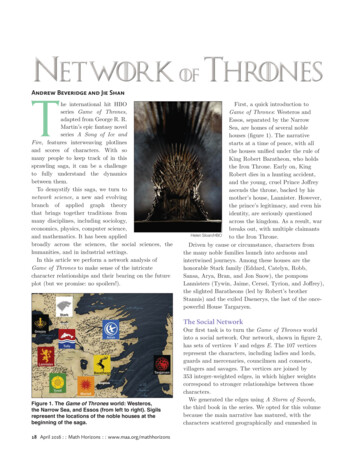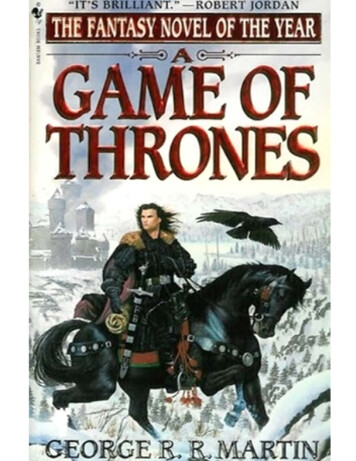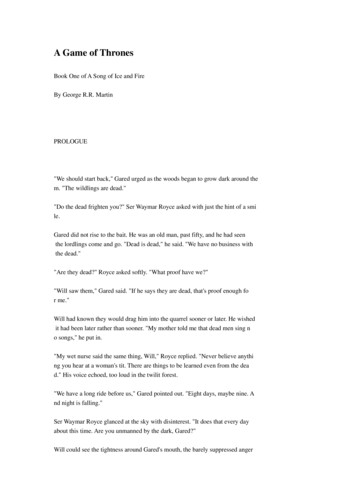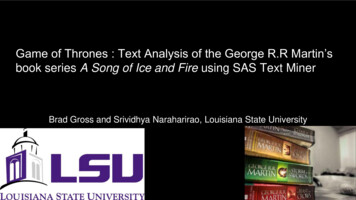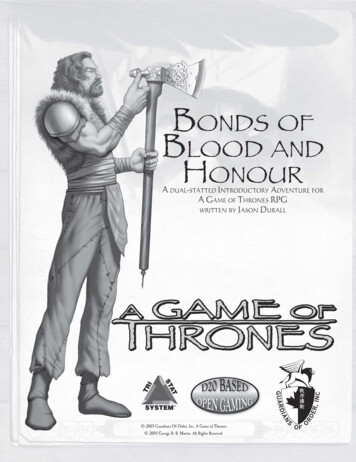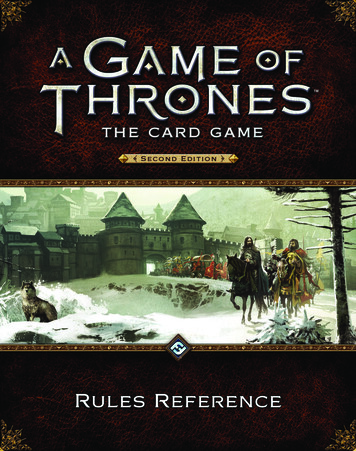
Transcription
TMRules Reference
The Only GameThat MattersGlossaryToo many strange faces, Tyrion thought, too manynew players. The game changed while I lay rotting inmy bed, and no one will tell me the rules.—George R.R. Martin, A Song of Ice and FireThe following is an alphabetical list of entries for gamerules, terms, and situations that may occur during play.AbilitiesAn ability is the special game text that a card contributesto the game. Card abilities fall into one of the followingtypes: actions, constant abilities, interrupts, keywords,reactions, or when revealed abilities.xxThe initiation of action, interrupt, and reactionabilities is optional. The word “may” also incorporatesa player option into the resolution of an ability. Theplayer who controls the card on which an optionalability exists determines whether or not he or shewishes to use that ability at the appropriate time.Halt!xxThe application or initiation of the following typesof abilities is mandatory: constant abilities, whenrevealed abilities, forced interrupt abilities, andforced reaction abilities.This document is intended as the definitive source forrules information, but does not teach players how toplay the game. Players should first read the Learn toPlay book in its entirety and use this Rules Referenceas needed while playing the game.The majority of this guide consists of the glossary,which provides an alphabetical listing of terms andsituations a player might encounter during a game.This section should be the first destination for playerswho have a rules question.The latter part of this guide contains two appendices.The first appendix provides detailed timing diagramsthat illustrate the structure of an entire game round, aswell as a detailed explanation on how to handle eachgame step presented in those diagrams. The secondprovides a detailed anatomy of each cardtype.The Golden RulesIf the text of this Rules Reference directly contradictsthe text of the Learn to Play book, the text of theRules Reference takes precedence.If the text of a card directly contradicts the text ofeither the Rules Reference or the Learn to Play book,the text of the card takes precedence.2xxThe initiation of any keyword which uses the word“may” in its keyword description is optional. Theapplication of all other keywords is mandatory.xxCard abilities only interact with, and can onlytarget, cards that are in play, unless the abilitytext specifically refers to an out of play area orelement. Card abilities on characters, locations, andattachments can only be initiated or affect the gamefrom an in play area unless they specifically referto being used from an out of play area, or requirethat the card be out of play for the ability to resolve.Event cards and agenda cards implicitly interact withthe game from an out of play area, as established bythe rules of their cardtypes.xxA card ability can only be initiated if its effecthas the potential to change the game state. Thispotential is assessed without taking into accountthe consequences of the cost payment or any otherability interactions.xxA card ability can only be initiated if its cost (aftermodifiers) has the potential to be paid in full.Related: Actions, Effects, Constant Abilities, Costs,Delayed Effects, Forced Interrupts/Forced Reactions,In Play and Out of Play, Interrupts, Keywords, LastingEffects, Reactions, Triggered Abilities, When Revealed[ Rules Reference ]
ActionsAmbush (X)Some Action abilities have a phase name as a qualifierto the word “Action.” Such abilities are still consideredAction abilities, with the restriction that they can only beinitiated during an action window in the specified phase.xxIf a card has multiple instances of ambush, each withAn action must be resolved completely before the nextaction can be initiated.Related: Keywords, Put into PlayAn action is a triggered ability that contains theboldface “Action:” precursor. These abilities can onlybe initiated by a player during an action window. Fordetails on when action windows occur during eachround, see the timing charts in Appendix I.Related: In Play and Out of PlayActive PlayerIn some phases, the game creates an active player, whois granted permission to perform a specified task.xxDuring the marshaling phase, the active playercollects income and is also permitted to marshalcharacter, location, attachment, and duplicate cardsfrom his or her hand.xxDuring the challenges phase, the active player ispermitted to initiate challenges.Ambush is a keyword ability. A player may, as a playeraction during the challenges phase, pay gold equal tothe (X) value of a card with ambush to put that cardinto play from his or her hand. A card that enters playusing ambush is not considered to have been marshaled.a different (X) value, the player controlling the cardmay choose which instance of ambush is used to putthe card into play.Attachment CardsAttachment cards represent weapons, armor, items,skills, conditions, and titles. These cards enter playstanding and attached to another card or game element,and remain in play unless removed by an ability, orunless the attached card leaves play. An attachmentcannot enter play if there is no eligible card or gameelement to which it can attach.xxAn attachment can only attach to a character, unlessotherwise specified by the attachment's text.xxThere is no limit on the number of attachments thatmay be attached to a card or game element.Related: Marshaling Phase, Challenges PhasexxIf a card to which an attachment is attached leavesAgainstDuring a challenge, the attacking player and thedefending player are considered to be taking part in thechallenge “against” each other.Agenda CardsAgenda cards are placed alongside a player’s factioncard, and provide specialized abilities and limitationsfor his or her deck. A player may use a single agendacard in conjunction with his or her faction card whenassembling a deck. The agenda card starts the gamenext to a player’s faction card and is revealed along withthe faction card during setup.xxAgenda cards are not considered “in play.” Their textaffects the game state from the out of play area whilethey are active beside a player’s faction card.xxCards with the printed agenda cardtype cannot beremoved from the game by other card abilities.For agenda card anatomy, see Appendix IIRelated: In Play and Out of Play, Deckbuildingplay, return the attachment to its owner’s hand.This occurs simultaneously with the attached cardleaving play.xxIf a situation arises in which an attachment is notlegally attached, discard the attachment.xxAn attachment a player controls remains under hisor her control even if the card or game element towhich it is attached is under an opponent’s control.xxAn attachment card stands and kneels independentlyof the card to which it is attached.For attachment card anatomy, see Appendix IIRelated: Ownership and ControlAttacker, Attacking Character,Attacking PlayerThe term “attacking character” refers to a character thatis participating in a challenge on the side of the playerwho initiated the challenge. The term “attacker” is alsoused as shorthand for “attacking character.”[ Rules Reference ]3
The term “attacking player” refers to the player thatinitiated the challenge that is currently resolving.Related: Challenges Phase, Defender, ParticipatingBase ValueThe value of a quantity before any modifiers are applied.For most quantities, it is also the printed value.Related: Printed, ModifiersBlankIf a card’s printed text box is considered “blank” by anability, that text box is treated as if it did not have anyof its printed content. Text and/or icons gained fromanother source are not blanked.xxA card’s text box includes: traits, keywords, cardtext and abilities, and non-challenge icons (such asgold, initiative, and reserve modifiers).Related: PrintedSome card abilities (usually interrupt abilities) can“cancel” other card or game effects. Cancel abilitiesinterrupt the initiation of an effect, and prevent theeffect from initiating. Because of this, cancel abilitieshave timing priority over all other interrupts to theeffect that is attempting to initiate.xxWhen an effect is canceled, that effect is nolonger imminent, and further interrupts(including cancels) cannot be initiated in referenceto the canceled effect.xxWhen the effects of an ability are canceled, theability is still considered to have been used, and anycosts have still been paid.xxIf the effects of an event card are canceled, the cardis still considered to have been played, and it is stillplaced in its owner’s discard pile.Related: Costs, Initiating Abilities, Interrupts, Limitsand Maxima, Triggering ConditionCannotThe word “cannot” is absolute, and cannot becountermanded by other abilities.The game’s cardtypes are presented in Appendix II,with detailed card anatomies, on page 30.4(such as an event card that changes into anattachment), it loses all other cardtypes it mightpossess and functions as would any card of thenew cardtype.Challenge IconsThese icons appear on most character cards and indicatewhich challenge types the character may be declared foras an attacker or defender. The challenge icons are:ChallengeGraphic IconIn TextMilitary Intrigue Power Challenges PhaseSee Appendix I, “4. Challenges phase” on page 27.CancelCardtypesxxIf an ability causes a card to change its cardtypeCharacter CardsCharacter cards represent the lords, ladies, knights,armies, mercenaries, creatures, and other personalitiesand groups one might encounter in the A Song of Iceand Fire setting. These cards enter play in the frontrow of a player’s play area and remain in play unlessremoved by an ability or game effect.For character card anatomy, see Appendix IIChooseThe word “choose” indicates that one or more targetsmust be chosen in order to resolve an ability.Related: TargetClaim or Claim ValueClaim represents the consequences a player must faceupon losing a challenge as the defending player.The claim value on a player’s revealed plot card (whichincorporates all relevant claim modifiers) determinesthe potency of each challenge that player initiates if heor she wins the challenge.Claim value determines: how many differentcharacters the losing opponent must kill (for a challenge), how many cards are discarded from thelosing opponent’s hand (for an challenge), or howmuch power is taken from the losing opponent’sfaction card (for a challenge).[ Rules Reference ]
xxAn ability cannot initiate (and therefore its costsRelated: Intrigue Claim, Military Claim,Power Claimcannot be paid) if the resolution of its effect will notchange the game state.Constant AbilitiesA constant ability is any non-keyword ability whose textcontains no boldface precursor defining its ability type.A constant ability becomes active as soon as its cardenters play and remains active while that card is in play.xxSome constant abilities continuously seek a specificcondition (denoted by words such as “during,” “if,”or “while”). The effects of such abilities are activeany time the specified condition is met.xxIf multiple instances of the same constant ability arein play, each instance affects the game state.Related: In Play and Out of Play, Ownershipand ControlDead PileThe dead pile is an out of play area. It is distinct fromthe discard pile.xxAny time a character in play is “killed,” thatcharacter is placed faceup on top of its owner’sdead pile.xxA player cannot marshal, play, put into play, or takecontrol of a copy of any unique ( ) card that is inhis or her dead pile.Related: In Play and Out of PlayControlxxA single instance of a unique card in a player’s deadSee “Ownership and Control” on page 14.Copy (of a card)A copy of a card is defined by title: any other card thatshares the same title is considered a copy, regardless ofcardtype, text, artwork, or any other characteristic ofthe card(s).Related: Deckbuilding, Ownership and Control,Unique Cards, Self-Referential TextCostsA card’s gold cost is the numerical value that must bepaid to marshal or play the card.Some card abilities are presented in a “do X to doY” construct. In such a construct, the “do X” aspect(preceding the word “to”) is a cost, and the “do Y” aspect(following the word “to”) is an effect.xxAn opponent’s game elements may not be used topay a cost.xxIf a cost requires a game element that is not inplay, the player paying the cost may only use gameelements that are in his or her out of play areas and/or gold pool to pay the cost.xxIf multiple costs for a single card or ability requirepayment, those costs must be paid simultaneously.xxIf any part of a cost payment is prevented, onceall costs that can be paid are paid, the process ofinitiating the ability or marshaling/playing the cardimmediately ends without further resolution. (Thecard remains unplayed in its owner's hand.)pile does not prevent an effect that would cause thecard to enter play directly from the dead pile. This isbecause such an effect removes the only instance ofthe card from the dead pile.xxEach player’s dead pile is open information, and maybe looked at by any player at any time.xxThe order of the cards in a dead pile may not bealtered unless a player is instructed to do so by acard ability.xxIf multiple characters are killed simultaneously, theowner of the cards may physically place them intohis or her dead pile one at a time, in any order.Related: Discard Pile, Leaves Play, Unique CardsDeck, Draw DeckWhen the word “deck” appears by itself in rules or incard text, it refers to the deck that contains a player’sattachment, character, event, and location cards. This isalso known as the “draw deck.”Any rule or ability that refers to a plot deck uses theterm “plot deck.”Related: Plot DeckDeckbuildingTo build a custom deck for sanctioned tournament play:xxA player must choose exactly 1 faction card.xxA player may choose 1 agenda card, or may chooseto not use an agenda.[ Rules Reference ]5
xxA player’s plot deck must contain exactly 7cards. Up to one of the chosen plot cards may beduplicated once (by title) within the plot deck. Nomore than 1 copy of each of the other plot cardsmay be in the plot deck.xxA player’s draw deck must contain a minimum of60 cards.immediately after their timing point/futurecondition occurs, before reactions to that momentmay be used.xxWhen a delayed effect resolves, it is not treated as anew triggered ability, even if the delayed effect wasoriginally created by a triggered ability.xxThere is no upper limit on a player’s draw deck size.xxRelated: Abilities, Effects, Triggered AbilitiesxxA player’s draw deck can only contain up to 3Discard Pilecopies (by title) of any given card.xxUnless instructed otherwise by a card ability,each card in a player’s deck and plot deck must beneutral or its affiliation must match the affiliationof that player’s faction card.Related: Copy, Deck, Deck Limits, Faction, Plot DeckDeck Limits, Deck Limit: XUp to 3 copies of most cards (by title) may be includedin a player’s deck. If a card has the text “Deck Limit:X” no more than X copies of that card may be includedin a player’s deck.xxIf X is 2 or lower, this phrase acts as adeckbuilding restriction.xxIf X is 4 or higher, this phrase acts as a permissionthat enables a player to include more than thestandard 3 copies.Related: Plot Deck Limit: XThe term “defending character” refers to a characterthat is participating in a challenge on the side of thedefending player. The term “defender” may also beused as shorthand for “defending character.”The term “defending player” refers to the opponent ofthe attacking player against whom (from the attackingplayer's perspective) the challenge is resolving.Related: Attacker, Challenges Phase, ParticipatingDelayed EffectsThe discard pile is an out of play area. It is distinctfrom the dead pile.xxAny time a card is “discarded” (from play or froman out of play area such as a hand or deck), it isplaced faceup on top of its owner’s discard pile.xxEach player’s discard pile is open information, andmay be looked at by any player at any time.xxThe order of the cards in a discard pile may not bealtered unless a player is instructed to do so by acard ability.xxIf multiple cards are discarded simultaneously, theowner of the cards may physically place them intohis or her discard pile one at a time, in any order.Related: Dead Pile, Leaves Play, SacrificeDominance PhaseSee Appendix I, “5. Dominance phase” on page 29.Drawing CardsDefender, Defending Character,Defending PlayerSome abilities contain delayed effects. Such abilitiesspecify a future timing point, or indicate a futurecondition that may arise, and dictate an effect that is tohappen at that time.6xxDelayed effects resolve automatically andWhen a player is instructed to draw one or morecards, those cards are drawn from the top of his or herdraw deck.xxWhen a player draws 2 or more cards as the resultof a single ability or game step, those cards are alldrawn simultaneously.xxDrawn cards are added to a player’s hand.xxThere is no limit to the number of cards a playermay draw each round.Related: Reserve ValueDraw PhaseSee Appendix I, “2. Draw phase” on page 27.[ Rules Reference ]
DuplicatesA player may use additional copies, by title, of anyunique card (indicated by a “ ” symbol in its title) heor she owns and controls in play as duplicates. Whena card enters play as a duplicate, it is placed faceup,overlapped by (i.e. partially visible beneath) the copy ofthe card that was already in play.A duplicate grants its controller the following triggeredgame ability: “Interrupt: When the overlapping uniquecard would leave play, discard this duplicate to save thatcard. (Cannot be canceled.)”xxThere is no cost to marshal a card as a duplicate.xxDuplicates are not considered attachments.Duplicates are not affected by and do not interactwith text that refers to attachments.xxDuplicates have no text, titles, characteristics, type,or traits. A duplicate is only considered a blank“duplicate card” while it is in play.xxIt is possible to have more than one duplicate on asingle card.xxA different version of a unique card may be used asa duplicate on the card. The version of the card thatwas first in play remains as the active version oncethe duplicate is attached. A player may not switch acard with its duplicate.xxMarshaling a duplicate is not considered marshalinga card of the duplicate’s printed type. It is onlyconsidered “marshaling a duplicate card.”Related: Ownership and Control, Save, Unique CardsEffectsA card effect is any effect that arises from the resolutionof ability text printed on, or gained by,a card. A framework effect is any effect that arises fromthe resolution of a framework event.xxCard effects might be preceded by costs, triggeringconditions, play restrictions, and/or play permissions;such elements are not considered effects.xxOnce initiated, players must resolve as much of eachaspect of the effect as they are able, unless the effectuses the word “may.”xxWhen a non-targeting effect attempts to engagea number of entities (such as “draw 3 cards” or“search the top 10 cards of your deck”) that exceedsthe number of entities that currently exist in thespecified game area, the effect engages as manyentities as possible.xxThe expiration of a lasting effect (or the cessation ofa constant ability) is not considered to be generatinga game state change by a card effect.Related: Abilities, Costs, Delayed Effects, LastingEffects, May, Initiating Abilities, Play Restrictions andPermissions, Triggering ConditionEnters PlayThe phrase “enters play” refers to any time a card makesa transition from an out of play area into a play area.Marshaling a card and putting a card into play by usinga card ability are two means by which a card mayenter play.Related: In Play and Out of Play, Marshal, Put Into PlayEvent CardsEvent cards represent tactical actions, schemes, twistsof fate, and other unexpected developments that mightoccur during the game.xxAn event card’s ability type, triggering condition (ifany), and play permissions/restrictions (if any) definewhen and how the card can be played.xxWhen a player plays an event card, its costs arepaid, its effects are resolved (or canceled), and thecard is placed in its owner's discard pile prior toopening the reaction window which follows theability's resolution.xxEvent card effects engage the game state at thetime they resolve. If an event card creates a lastingeffect on a set of cards, only cards that are in play atthe time the event card is played are eligible to beaffected. Cards that enter play after the resolution ofthe event are not affected by its lasting effect.xxIf the effects of an event card are canceled, the cardis still considered to have been played, and its costsremain paid. Only the effects have been canceled.xxUnless the ability that puts it into play also changesits cardtype to a cardtype that is permitted in play,an event card cannot enter play.For event card anatomy, see Appendix IIRelated: Cancel, Costs, Delayed Effects, LastingEffects, Play Restrictions and Permissions,Triggering Condition[ Rules Reference ]7
Facedown CardsSome abilities put cards into play facedown. A facedowncard has no inherent attributes other than “facedowncard,” but it may be granted attributes by the card abilitythat put it into play.xxA player may look at the identity of any facedowncard that is in play and under his or her control.Faction, Faction CardsThe faction card signals which faction a player haschosen as the primary faction for his or her deck. Anin-faction card bears the loyal or non-loyal factionsymbol that matches the affiliation indicated by his orher faction card.For faction card anatomy, see Appendix IIRelated: Deckbuilding, For Your Faction, Loyal8LoyalNon-LoyalA first player is chosen at random during setup. A newfirst player is chosen each plot phase by the player whowins initiative. The chosen player remains the firstplayer until a new first player is chosen. The first playertoken is used to indicate which player is the first player.xxThe first player becomes the active player firstduring the marshaling and challenges phases.xxDuring all framework event and action/reaction/There are 8 factions in the game, shown in thechart below.FactionFirst Player, First Player TokenIn TextHouseStark HouseLannister HouseBaratheon HouseGreyjoy HouseTyrell interrupt windows the first player has the firstopportunity to initiate action, interrupt, or reactionabilities at each appropriate game moment.xxFor any question as to who should perform an actor make a decision first, in the absence of any otherdirection by card or rules text, the first player doesso first, and other players follow in player order.xxIf the first player is eliminated from a game, theplayer to his or her left becomes the first player.Related: Active Player, Setup, Initiative,Plot Phase, Priority of Simultaneous ResolutionForced Interrupts/Forced ReactionsWhile most triggered abilities are optional, someinterrupt and reaction abilities are preceded bythe word “Forced.” Such abilities must be resolvedimmediately whenever the triggering conditionspecified in the ability text occurs.xxFor any given triggering condition, forcedinterrupts take priority and initiate before nonforced interrupts, and forced reactions take priorityand initiate before non-forced reactions.xxIf two or more forced abilities would initiate at thesame moment, the first player determines the orderin which the abilities initiate, regardless of whocontrols the cards bearing those abilities.xxEach forced ability must resolve completely beforeHouseMartell HouseTargaryen The Night’sWatch the next forced ability to the same triggeringcondition may initiate.Related: Interrupts, ReactionsFor Your FactionThe phrase “for your faction” is used to instruct aplayer to place the power just gained on his or herfaction card.[ Rules Reference ]
Framework Effects and Framework EventsA framework event is a mandatory occurrencedictated by the structure of the game. A frameworkeffect is any effect that arises from the resolution ofa framework event.Related: Appendix I: Timing and Gameplay, EffectsGainsThe word “gains” is used in multiple contexts.xxIf a player gains gold, the player takes the specifiedamount of gold from the treasury and adds it to hisor her gold pool.xxIf a player gains power for a card under his or hercontrol, the player takes the specified amount ofpower from the treasury and adds it to the card.xxIf a card gains a characteristic (such as an icon, aTrait, a keyword, or ability text), the card functionsas if it possesses the gained characteristic. Gainedcharacteristics are not considered to be printed onthe card.Related: Gold, Power, PrintedImmunity only protects a card from effects. It does notprevent a card from being used to pay costs.Related: Costs, Lasting EffectsIn Play and Out of PlayThe cards (generally characters, locations, attachments,duplicates, and the faction card) that a player controls inthe play area, the title card a player currently bears in amelee game, as well as a player’s revealed plot card, areconsidered “in play.”“Out of play” refers to all other cards and areas involvedin the game environment, including: cards in a player’shand, deck, discard pile, dead pile, plot deck, used pile,agendas, and any cards that have been removed fromthe game.play origin to a play area.xxA card leaves play when it transitions from a playarea to an out of play destination.xxA player’s faction card cannot leave play.Gold TokensGold begins the game in the treasury. When a playergains gold, that player takes an equivalent amount ofgold from the treasury and adds it to his or her goldpool. When gold is spent it is returned to the treasuryfrom a player's gold pool.Related: Marshaling Phase, Taxation PhaseGold ModifierSee “Plot Value Modifiers” on page 16.ImmuneIf a card gains immunity to an effect, pre-existinglasting effects that have been applied to the card arenot removed.xxA card enters play when it transitions from an out ofGoldGold is the game’s currency andis used to pay for cards and cardabilities. The amount of gold aplayer has available at any giventime is represented (as openinformation) by gold tokensin his or her gold pool.immune card (such as attachments, tokens, abilitiesoriginating from an immune card, or duplicates) are notthemselves immune.If a card is immune to a specified set of effects (forexample, “immune to event card effects,” or “immuneto card effects”), it cannot be targeted or affectedby effects that belong to that set. Only the card itselfis protected, and peripheral entities associated with anxxOutside of the process by which a player reveals anew plot his or her previously revealed plot cardenters the used pile, a player's plot card cannotleave play.Related: Abilities, Dead Pile, Deck, Discard Pile,Plot CardIncomeWhen a player becomes the active player during themarshaling phase, that player collects income bygaining an amount of gold from the treasury equalto the gold value on his or her revealed plot card(which incorporates the total value of all relevantgold modifiers).Related: Gold, Gold Modifier, Marshaling Phase[ Rules Reference ]9
Influence TokensInfluence tokens are generic tokensthat can be used to track a varietyof different game states and statuses.Influence TokensThey have no inherent rules.(double-sided)xxCard abilities can create anddefine a number of different token types, suchas “betrayal tokens,” “poison tokens,” and “standtokens.” When such a token is called for, aninfluence token is used to track its presence inthe game.Initiating Abilities/Marshaling CardsWhen a player wishes to marshal or play a card, orinitiate a triggered ability, that player first declareshis or her intent (and shows the card to be used, ifnecessary). The following steps are then observed,in order:1. Check play restrictions: can the card be marshaledor played, or the ability initiated, at this time?2. Determine the cost (or costs, if multiple costsare required) to marshal/play the card or initiatethe ability. If it is established that the cost (takingmodifiers into account) can be paid, proceed withthe remaining steps of this sequence.3. Apply any modifiers to the cost(s).4. Pay the cost(s).5. Choose target(s), if applicable.6. The card is marshaled/played, or the effects of theability attempt to initiate. An interrupt ability thatcancels this initiation may be used at this time.7. The effects of the ability (if not canceled instep 6) complete their initiation, and resolve.Interrupts and Reactions may be used throughoutthis process as normal, should their triggeringconditions occur.Related: Abilities, Cancel, Costs, Play Restrictionsand Permissions, TargetInitiativeA player’s initiative is the initiative value on his or herrevealed plot card (which incorporates the total valueof all relevant initiative modifiers).10When new plot cards are revealed for the plot phase,the players compare initiative. The player with thehighest initiative value wins initiative, and chooseswhich player is the “first player” until a new first playeris chosen.If there is a tie at that time for initiative, the tiedplayer with the lowest power total wins initiative. Ifthe lowest power total is also tied, a random methodshould be used to break this tie.Related: First PlayerInitiative ModifierSee “Plot Value Modifiers” on page 16.InsightInsight is a challenge resolution keyword. Aftera player wins a challenge, for each participatingcharacter with the insight keyword he or she controls,that player may draw 1 card.Related: Challenges Phase, KeywordsInsteadSee “Replacement Effects” on page 18.InterruptsAn interrupt is a triggered ability whose text containsthe boldface “Interrupt:” precursor. An interruptability interrupts the resolution of its triggeringcondition, sometimes canceling or changing theresolution of that condition. Always resolve interruptsto a triggering condition before resolving theconseq
The game changed while I lay rotting in my bed, and no one will tell me the rules. —George R.R. Martin, A Song of Ice and Fire This document is intended as the definitive source for rules information, but does not teach players how to play the game. Players should first read the Learn to Play b

